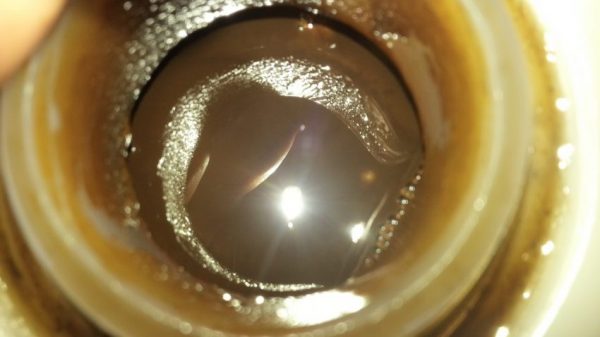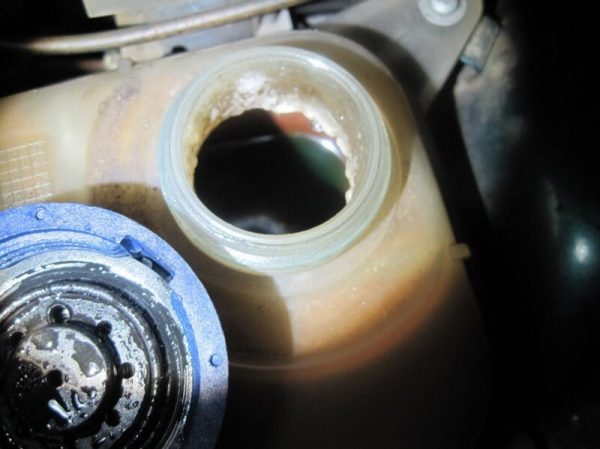
Why oil appeared in the engine: be careful, driver!
Content
During normal engine operation, oil and coolant move along different lines and do not intersect with each other. When some elements of the engine fail, a malfunction occurs in which oil enters the antifreeze. If such a situation arises, it is necessary to determine the cause of the breakdown and know how to fix it.
Signs and causes of oil getting into antifreeze, how it is dangerous
The presence of oil in the cooling system is indicated by a number of signs that every driver should be aware of. Since these fluids should not intersect with each other, it does not matter how much grease gets into the antifreeze. Any amount of it indicates a problem, therefore, in order to prevent costly repairs, it is necessary to urgently identify and eliminate the cause.
Main features:
- the color and consistency of antifreeze changes. Normal antifreeze is a clear liquid that can be of different colors. During operation of the motor, its natural darkening occurs, but this takes quite a lot of time. If you notice a rapid darkening of the coolant and an increase in its viscosity, as well as oil stains, this indicates that lubricant has entered it. Oily deposits appear on the lid;
 Oily deposits appear on the radiator cap or expansion tank
Oily deposits appear on the radiator cap or expansion tank - when you open the radiator, a greasy dark film is visible on top of the liquid. Sunlight is reflected in it, and it shimmers with different colors;
 When oil gets into antifreeze, it changes color, becomes darker and more viscous.
When oil gets into antifreeze, it changes color, becomes darker and more viscous. - pure antifreeze evaporates from the surface of the fingers, and if there is oil in it, an oily film remains on them when the coolant is rubbed;
- a change in smell, a burnt aroma appears, the more oil gets in, the brighter the smell of antifreeze;
- The engine gets very hot. The presence of oil in the coolant reduces its performance and boiling point. This is especially noticeable in hot weather, when the motor overheats, it starts to work unstable;
- oil spots appear on the walls of the expansion tank;
- at high engine speeds, air bubbles appear in the liquid in the expansion tank;
- white smoke from the exhaust pipe.
When the described symptoms appear, it is necessary to urgently look for the cause of such a malfunction. For all vehicles, the reasons for mixing oil and coolant will be the same, regardless of whether they have a gasoline engine or a diesel engine.
Main reasons:
- cylinder head malfunctions: cracks, deformation;
- damage to the cylinder head gasket;
- breakdown of the pump;
- breakdown of the oil cooler or oil cooler;
- corrosion of liners;
- damage to the heat exchanger gasket or its wear;
- malfunction of the radiator and pipes;
- damage to the oil lines of the lubrication system.
Often, when the liquid level in the cooling system decreases, drivers top up the one that is at hand. If the characteristics of antifreeze do not match, a reaction may occur, leading to damage to the lines and elements of the cooling system, and oil begins to get into it.
If you do not pay attention to the signs of oil penetration into the antifreeze and do not take timely measures to eliminate the problem, this will lead to more serious consequences:
- rapid wear of bearings, as they operate in an inappropriate environment;
- corrosion of the cylinder walls occurs. Antifreeze begins to enter the combustion chamber, this leads to a water hammer, leading to a seizure of the motor;
- Mixing oil and antifreeze causes a reaction causing neoplasms to enter the oil filter and clog it. The process of engine lubrication is disrupted;
- the oil increases the viscosity of the coolant and the engine starts to overheat.
Video: reasons for mixing oil and antifreeze
Destruction of the oil line in the cylinder block
On a running car, the oil in the lubrication system is under high pressure. If cracks appear in the system, then it begins to mix with antifreeze. The radiator honeycomb begins to clog, the engine overheats and this can lead to its seizure.
Such a malfunction can only be determined after a complete disassembly of the motor. Diagnostics is carried out by checking the engine in water under high air pressure. For this, special equipment is used. Air will escape in places where the lines are damaged. Troubleshooting is carried out by installing a metal tube into the damaged line. Such a procedure can only be done by specialists at a service station where the necessary equipment is available. If this fails, you will have to completely change the cylinder block.


Worn cylinder head gasket
When the integrity of the cylinder head gasket is broken, the oil and antifreeze channels are connected and these fluids are mixed. Timely replacement of the cylinder head gasket solves the problem. Usually, grinding of the head is still required, as its geometry changes. It is better to grind the head on special equipment. Some craftsmen do it at home. They use a new emery wheel for this, rubbing the surface to be leveled with its flat side. In this way, it will not work to achieve a uniform removal of the metal layer and it is not recommended to do this. After that, the gasket is selected in accordance with the amount of metal removed during grinding.
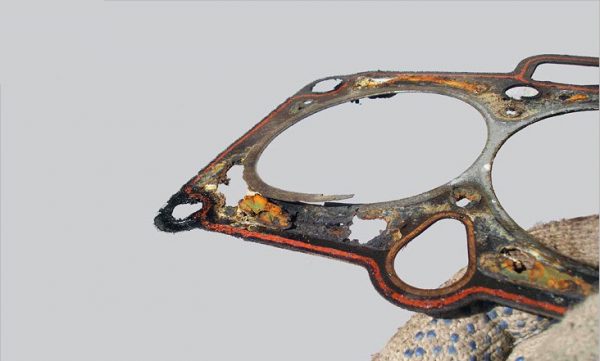

The principle of replacing the cylinder head gasket for different cars will be the same:
- Preparatory stage. Remove all attachments that will interfere with the dismantling of the cylinder head.
- Dismantling. First, the head bolts are cleaned of dirt. Then, starting from the middle, unscrew all the bolts one turn. After that, unscrew them completely and remove the head.

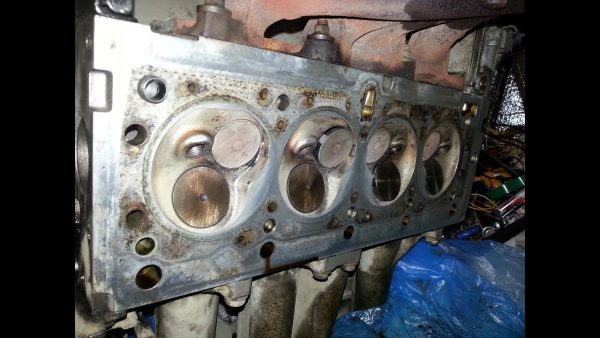 Remove the head and check the quality of its surface to identify shells and cracks
Remove the head and check the quality of its surface to identify shells and cracks - Replacing the gasket. The old gasket is removed and a new one is installed in its place.
- Assembly is carried out upside-down. For different cars, the order of tightening the cylinder head bolts may differ, so you need to find the appropriate diagram.
Cracks in the cylinder head body
If oil gets into antifreeze on a motor that does not have an oil separator, then most likely the reason is the presence of a crack in the cylinder head. To identify a malfunction, you will have to remove the head and during its crimping, determine the location of the damage. If there is normal access to the crack, then it is welded, they do it with argon welding, but not every service station has it. In addition, after welding work, it is necessary to clean the restored place and polish it. Only a specialist can qualitatively do such work. In the event that there is no access to the place of damage, you will have to change the cylinder head.
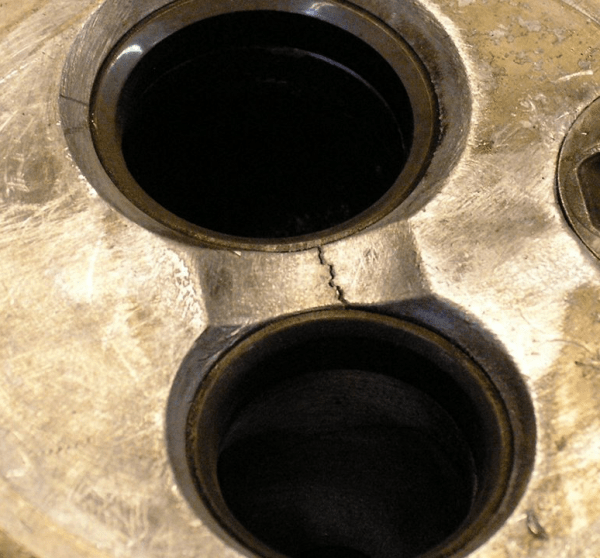

If a crack appears in the cylinder, it will not be possible to independently identify and cope with the problem. In this case, you need to contact a specialist. At the stand, they will be able to determine the location of the damage. The repair consists in casing the block. This can only be done in a service station in two ways:
- cooling the liner with liquid nitrogen;
- block heating.
After that, the hole in the block is lubricated with sealant and the sleeve is pressed in.


Heat exchanger gasket worn out
The problem can arise if the sealing elements of the heat exchanger (oil cooler) are damaged. To eliminate the malfunction, you need to drain the antifreeze, remove the heat exchanger, rinse and clean everything well. All gaskets are replaced with new ones. You should not save on this, even if it seems to you that the gasket is still normal.
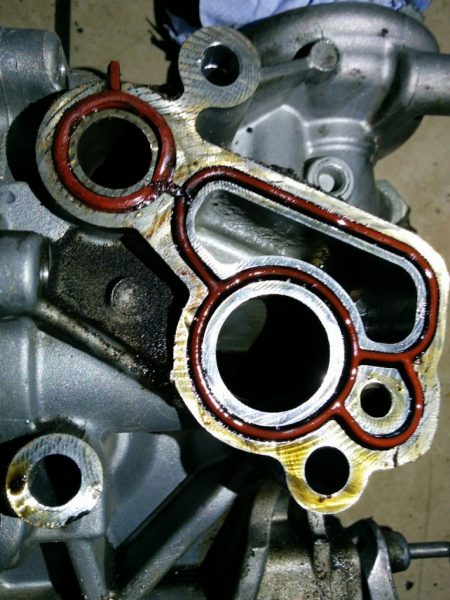

If the heat exchanger is cracked, it will have to be replaced. Before dismantling the heat exchanger, several flushes of the cooling system are performed. To do this, use distilled water until it is completely clean when draining.
Other reasons
In addition to the reasons described, the appearance of oil in antifreeze can occur in such cases:
- Deformation of the cylinder head. This happens when the engine overheats. The malfunction is eliminated by grinding the head.
- Damage to the pipes. After identifying damaged parts, they must be replaced.
- Water pump worn out. If the reason is a malfunction of the water pump, you will have to remove it and install a new one.
Troubleshoot problems
You can fix some problems yourself. If the oil in the antifreeze appears due to problems with the oil cooler gasket, then its replacement is carried out as follows:
- Flushing the cooling system. Add a special fluid to the radiator and start the engine. After its operation for 5-10 minutes, the fan will turn on, this will indicate that the engine is warmed up, after which it is turned off.

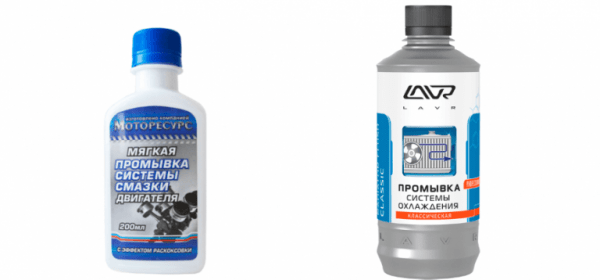 The cooling system is flushed with a special liquid
The cooling system is flushed with a special liquid - Draining of waste liquid. Unscrew the plug on the radiator and drain the liquid into the prepared container.

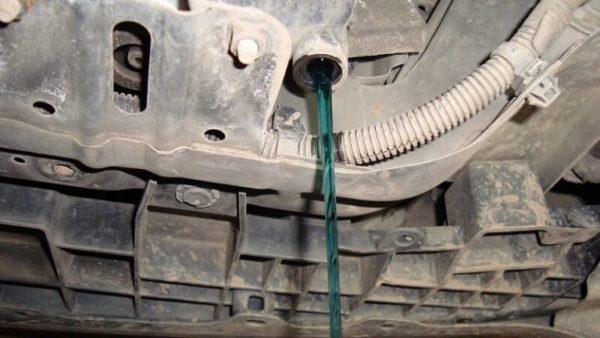 Used antifreeze is drained from the cooling system
Used antifreeze is drained from the cooling system - Dismantling the oil cooler. The sequence of work will differ on different cars, therefore it is carried out in accordance with the design of the car.
- Dismantling and cleaning the oil cooler. Remove worn gaskets and install new ones.

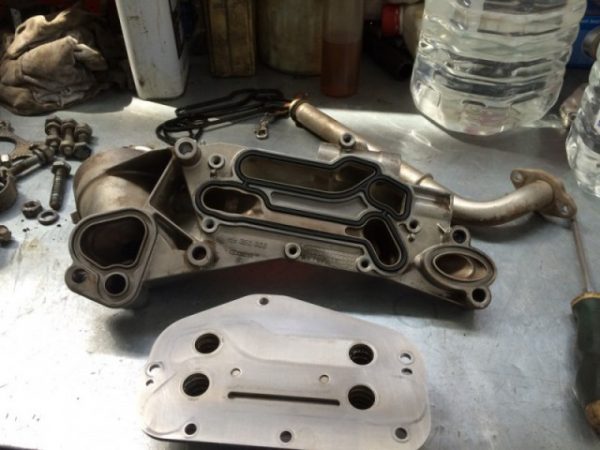 Remove the oil cooler, clean it of deposits and install new gaskets
Remove the oil cooler, clean it of deposits and install new gaskets - Flushing and cleaning the expansion tank.
- Tank and oil cooler installation. The removed parts are installed in place.
- Re-wash. Do this with distilled water. It is poured into the cooling system, the engine is warmed up and drained. Perform the procedure several times until clean water is drained.

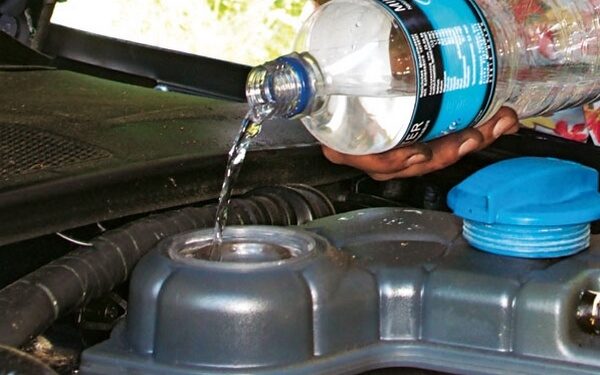 After replacing the oil cooler gaskets, flush the engine with distilled water
After replacing the oil cooler gaskets, flush the engine with distilled water - Coolant filling. After that, the resulting plugs must be removed. The engine starts and one person must press the accelerator to increase engine speed, and the second at this time compress the cooling system pipe. The expansion tank cap must be closed. After that, the lid is opened and excess air is released.

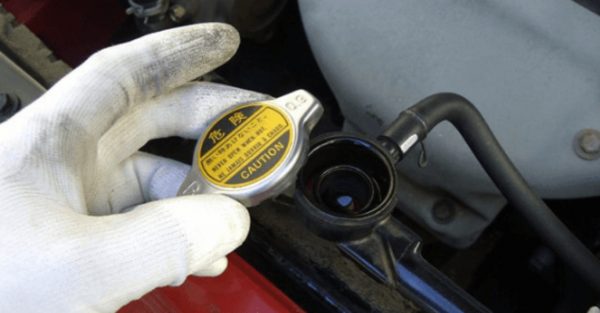 When removing plugs, the cap of the expansion tank must be closed, and then it is opened and excess air is released
When removing plugs, the cap of the expansion tank must be closed, and then it is opened and excess air is released
Video: replacing heat exchanger gaskets


Watch this video on YouTube
Can I drive with oily antifreeze
If signs of oil entering the cooling system are detected, the car can only be operated to drive home or the nearest service station. It is necessary to eliminate the detected malfunction as quickly as possible. Operating a car in which grease and antifreeze are mixed for a long time will lead to serious breakdowns, so you need to act quickly in order to get out of the situation that has arisen with minimal consequences and minimal cost of money.
To avoid such problems, if you need to add antifreeze, you must use only the same liquid as already filled. It is necessary to monitor the technical condition of the vehicle. If you find signs that indicate that oil is entering the cooling system, you need to find the cause and fix it immediately. If you cannot do this on your own, you need to contact a specialist.


